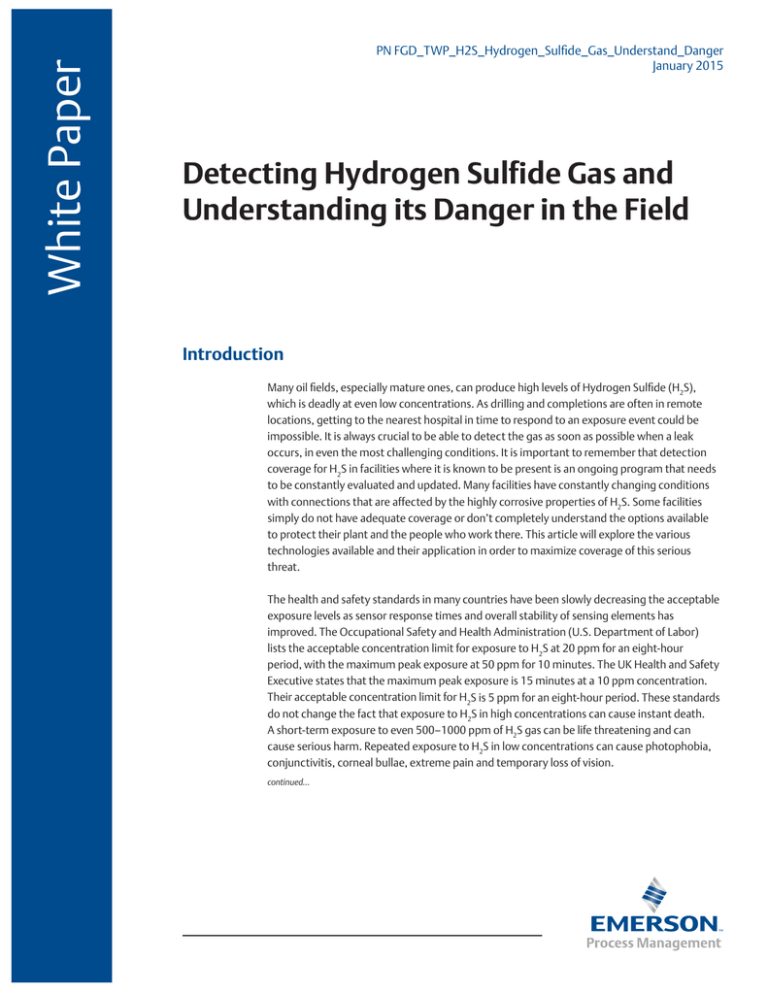Technical White Paper - Emerson Process Management
advertisement

White Paper PN FGD_TWP_H2S_Hydrogen_Sulfide_Gas_Understand_Danger January 2015 Detecting Hydrogen Sulfide Gas and Understanding its Danger in the Field Introduction Many oil fields, especially mature ones, can produce high levels of Hydrogen Sulfide (H2S), which is deadly at even low concentrations. As drilling and completions are often in remote locations, getting to the nearest hospital in time to respond to an exposure event could be impossible. It is always crucial to be able to detect the gas as soon as possible when a leak occurs, in even the most challenging conditions. It is important to remember that detection coverage for H2S in facilities where it is known to be present is an ongoing program that needs to be constantly evaluated and updated. Many facilities have constantly changing conditions with connections that are affected by the highly corrosive properties of H2S. Some facilities simply do not have adequate coverage or don’t completely understand the options available to protect their plant and the people who work there. This article will explore the various technologies available and their application in order to maximize coverage of this serious threat. The health and safety standards in many countries have been slowly decreasing the acceptable exposure levels as sensor response times and overall stability of sensing elements has improved. The Occupational Safety and Health Administration (U.S. Department of Labor) lists the acceptable concentration limit for exposure to H2S at 20 ppm for an eight-hour period, with the maximum peak exposure at 50 ppm for 10 minutes. The UK Health and Safety Executive states that the maximum peak exposure is 15 minutes at a 10 ppm concentration. Their acceptable concentration limit for H2S is 5 ppm for an eight-hour period. These standards do not change the fact that exposure to H2S in high concentrations can cause instant death. A short-term exposure to even 500–1000 ppm of H2S gas can be life threatening and can cause serious harm. Repeated exposure to H2S in low concentrations can cause photophobia, conjunctivitis, corneal bullae, extreme pain and temporary loss of vision. continued... The toxicity of H2S gas is extremely high. Its flammable level is actually much lower than it’s toxic level for humans. Fortunately, having the distinct odour of rotten eggs allows plant workers to detect H2S gas in the relatively safe range of parts per billion. This is well below the danger level, however exposure to very low concentrations (30 parts per million or greater) can actually paralyze a workers ability to smell H2S. Training for rig and plant personnel includes extensive coverage of H2S gas dangers and what to do if detected but in some cases all the training in the world cannot help with a sudden high level exposure. Consider the following common scenario: A technician in an oil and gas facility is rushing to complete some routine maintenance towards the end of the day. Suddenly he feels a slight irritation in his eyes and then smells rotten eggs. The worker stops and cautiously investigates the area. In that moment a slight change in airflow moves the released gas just slightly out of his range. The odour quickly fades away, so he believes that only low levels of the gas were present and carries on with his work. A large number of workers would do just the same, dangerously assuming that there is no issue continuing to work in the area since no alarm had been triggered, sacrificing precious seconds required to react and reach a safe area should even a small amount of highly toxic H2S be present. Considerations for H2S Exposure In Oil & Gas Facilities The primary goal of any fixed point H2S detection system is to safeguard workers by warning them of the presence of hazardous toxic levels of H2S in their workplace. The explosive levels of H2S are not generally considered in safety applications. Exposure to levels of H2S levels at 1000 ppm can cause death, which is several magnitudes lower than the Lowest Explosive Level of the gas. The use of personal gas detectors, or hand-held portable gas detectors, in combination with a comprehensive fixed gas detection system is excellent practice for complete site safety. In many countries standards exist that require every worker in a potentially hazardous area to be equipped with a personal gas detector. As manufacturers continue to improve toxic gas detection technology, it is important to understand how these may be applicable in your Oil and Gas installation. Electrochemical and metal oxide semiconductor (MOS) cells have for many years been the only field-proven toxic sensing technologies but more advanced optical sensing technologies are now emerging and have widened the scope. Risk areas are present in numerous applications within the Oil and Gas industry as well as other industries such as mining, life sciences, wastewater and power generation. When an H2S gas release occurs due to a loss of integrity event, a complete Hazardous Risk Analysis of the facility should be performed to identify the existing and other potential sources of leaks. It is also important to note that H2S being heavier than air, sinks to the lowest lying area. Sensing elements must be positioned accordingly to optimize performance. Factors such as wind speed, direction as well as changing humidity and temperature can also affect the detector‘s performance. H2S detectors process both the specific and changing factors of the environment as well so it is crucial for these to be considered with the detector placement in order to ensure peak performance in case of a H2S leak. Many oil and gas companies are beginning to focus operations in areas with extreme hot or cold climates. It is a real challenge to operate safely and efficiently in these conditions and its imperative operators select the correct type of H2S detection technology for dealing with extreme environmental conditions. Metal Oxide Semiconductor (MOS) Sensors For the purposes of this article we will refer to two types of MOS sensors: “traditional” sensor materials using somewhat dated technology; and the latest “nano-enhanced” MOS sensor materials which have dramatically improved the overall performance of this sensor type. continued... 2 The typical construction of an MOS sensing element includes a platinum heater element, an insulation medium and the sensing element itself, which is a gas-sensitive resistive film. This film will employ traditional materials or materials that are enhanced at the nano-level to improve performance. When H2S comes into contact with this film there are measurable changes in the electrical conductivity. These changes are typically amplified in a transmitter device. MOS detectors have a long life compared to electrochemical sensors and continue to operate in wide ranging temperatures, particularly high temperatures, as well as in extremely dry conditions. Similar to electrochemical detectors, MOS detectors are not fail-safe and a change in oxygen levels may affect their output. The following are the primary challenges that traditional MOS sensors experience: Slow H2S response time (up to 120 seconds at T90 for some manufacturers!) Sensors “fall asleep” – completely stop functioning until bump tested, with no failure alert Improved performance in extreme temperature and humidity Recently, advances in nano-enhanced material construction have been able to effectively deal with the above challenges. While the appearance and operating principle of an NE-MOS sensor is identical to that of a traditional MOS sensor, NE-MOS benefits from a mechanically conformed array of sensing components known as “nanotubes” being applied to the resistive film in a manner in which they are perfectly aligned, symmetric, and extremely concentrated during the manufacturing process. Traditional materials are produced using a process that leaves gaps and creates irregularities, resulting in the performance challenges outlined above. Nano-enhanced materials equate to increased overall sensing capability, faster response, and much higher stability. With its advanced design NE-MOS sensors can, in some applications, respond faster than both the electrochemical and traditional MOS sensors. NE-MOS response to T50 (the time it takes for the detector to reach 50 % of full-scale concentrations) can be as quick as 10 seconds. It responds to T90 in approximately 15 seconds. The latest design has also been able to include electronic temperature and humidity compensation, enabling NE-MOS detectors to function efficiently in the even most extreme climate conditions. Electrochemical Detectors In an electrochemical sensor the cells combine enclosed electrodes and electrolyte. H2S diffuses through a permeable membrane, the volume of H2S increases in the air, an oxidation or reduction reaction occurs at one of the electrodes, and as a result, a linear current change occurs. This enables a display or an amplifier device to generate an indication of the H2S level. These detectors also have high sensitivity and repeatability, which has established this as the toxic detection technology of choice in a wide variety of applications. The use of electrochemical sensors in desert and arctic regions is not the ideal solution though. The detector’s lack of resilience in high and low temperatures and the effect of humidity on the detector’s performance are serious considerations. The capability of the sensor and its performance life will likely be affected due to evaporation of electrolytes in dry, hot conditions. Extreme cold conditions may also reduce the detector’s speed of response. Normally one can expect a T90 response in around about 30 seconds in temperate conditions. When you start to approach -20 °C the detector’s speed of response reduces significantly, as temperatures continue to lower the output will decrease even further. Other considerations with electrochemical sensors are that they do require routine calibration, every six months is typically recommended. It may be required more frequently depending on the site conditions. The sensors are continued... 3 not inherently fail-safe but some manufacturers have employed electronic sensor health monitoring which will generate a fault output. And electrochemical detectors are all cross sensitive to other specific types of gases which need to be considered during installation to avoid exposure to these contaminants. Optical Sensing Technology Optical hydrocarbon detectors are a field-proven detection solution in many industrial applications and optical H2S detectors use the same basic operating principle. In an optical H2S sensor, the signal is absorbed by the H2S gas as it passes through the detector’s optical path. The sensor will record the signal reduction and a micro-processor will calculate a corresponding gas value. Because the sensor uses positive feedback at its zero gas level, this technology is inherently fail safe. Any internal damage to the detector results in an impact on processing so they must continuously perform valuable fault diagnostics to ensure optimum performance, which also compensates effectively for temperature and humidity. Optical sensors are deployed as either a fixed point-type detectors or an open path installation. Fixed point-type gas detectors must be strategically located to effectively provide coverage for a targeted area. Regular routine inspections are good practice but full calibrations are typically only required every 12 months. Open path or line-of-sight (LOS) detectors use employ an optical transmitter and a paired receiver located at a maximum specified distance apart which monitor the space between them. Any volume of the H2S gas passing through the beam of light will provide a reading. But it is not currently possible to accurately determine the ppm level with this technology. They also cannot have any obstructions to their path, which makes their effective application somewhat limited in areas where workers are constantly present. They are well suited for monitoring gas migration into perimeter areas of an installation. Final Thoughts on H2S Monitoring Manufacturers of H2S sensing solutions face several unique challenges in a wide variety of applications. As the current oil and gas fields located in hospitable regions are completing their life cycle, there is going to be a fundamental shift to the more extreme operating locations of the world. In this context, it is critical that the safety devices perform at a high level in these conditions in order to protect plant and personnel as well as maximize uptime in these locations that require more capital to operate. Operators need to consider specific application and environmental conditions to be able to select the best available technology that will provide the highest degree of safety and performance. As new technologies emerge it may become possible to combine the point type devices, open-path optical detectors, with new and emerging technologies like ultrasonic gas leak detection and laser-based sensing for providing enhanced safety to support even higher standards. The ISA performance standard (ISA 92.0.01,Part I) for H2S detectors is an excellent minimum requirement policy to adopt for plant safety. Third party testing and approvals will also provide operators with performance qualifications on the multitude of options available in the market place. All these resources are helping to improve the workplace’s safety standards, ensure that you make an informed decision when you select your H2S detector and be confident in its performance and capability, as well as the ability of the entire detection platform to improve your overall processes. 4 References: U.S. Department of Labor, Occupational Safety & Health Administration - http://www.osha.gov/pls/oshaweb/owadisp.show_document?p_table=STANDARDS&p_id=9993Health and Safety Executive (HSE) - http://www.hse.gov.uk/coshh/table1.pdf 5 HEADQUARTERS Emerson Process Management Flame & Gas Detection 2721 Hopewell Place NE Calgary, Alberta, Canada T1Y 7J7 T +1 (403) 219 0688 T +1 866 347 3427 F +1 (403) 219 0694 www.safety.csc@emerson.com www.emersonprocess.com/safety © Rosemount Analytical Inc. 2015

